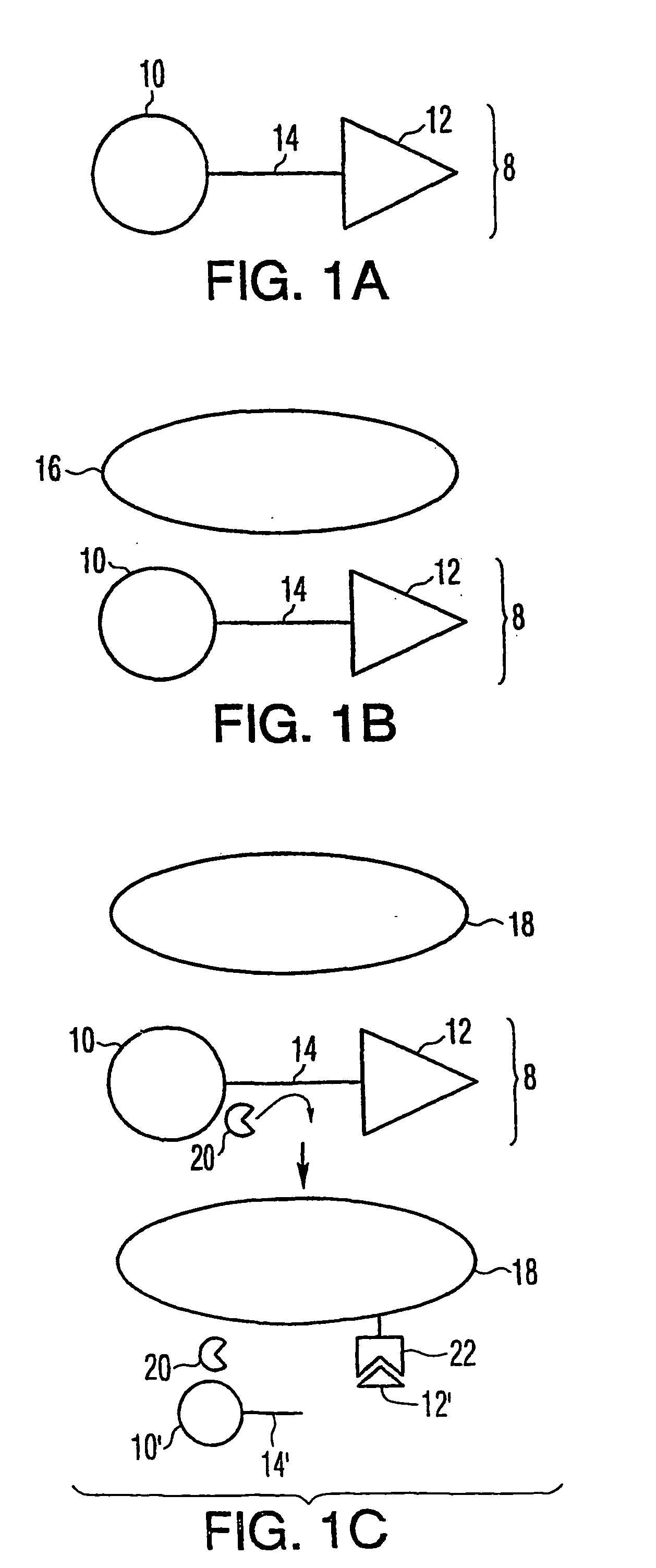Tumor activated prodrug compounds and methods of making and using the same
a technology of prodrug compounds and tumors, applied in the field of tumor-activated prodrug compounds, can solve the problems of affecting normal tissues that contain rapidly dividing cell populations, current cancer therapy attempts suffer from several major deficiencies, and achieve the effect of improving therapeutic properties and lowering toxicity
- Summary
- Abstract
- Description
- Claims
- Application Information
AI Technical Summary
Benefits of technology
Problems solved by technology
Method used
Image
Examples
example 1
6. EXAMPLE 1
Tumor Selective Prodrug of TNF.alpha.
[0191] In this example, we describe a prodrug formulation of TNF.alpha.. To prepare the prodrug, the biologically active entity TNF.alpha. is linked to a plurality of polyethylene glycol masking moieties via tetrapeptide linking moieties.
[0192] The PEG moieties are linked to TNF.alpha. via the tetrapeptide linking moiety Ala-Leu-Ala-Leu. The tetrapeptide linker Ala-Leu-Ala-Leu is selected because it is known to allow the generation of protein-drug conjugates that are resistant to blood peptidases (Trouet et al., 1982, Proc. Natl. Acad. Sci. USA 79:626-629).
[0193] Leucyl-Derivatives of TNF.alpha.
[0194] With a prodrug comprising an alanyl-leucyl-alanyl-leucyl linker, extracellular hydrolysis in the tumor environment liberates a leucyl-derivative of the biologically active entity. To determine the appropriate stoichiometry for modification of TNF.alpha., leucyl-derivatives are first prepared. Leucine residues are linked covalently throug...
example 2
7. EXAMPLE 2
Tumor-Activated Dual TNF.alpha.--Doxorubicin Prodrug
[0207] In this example, we present a dual prodrug that releases TNF.alpha. and the antineoplastic entity doxorubicin at target cells in vivo.
[0208] First, -Mal-Leu-OH derivatives of TNF.alpha. are prepared. The amino terminus of leucine methyl ester (Leu-OMe) is modified with dimethylmaleic anhydride to yield dimethylmaleyl leucine (Mal-Leu-OMe). Free amino moieties of TNF.alpha. are then modified by forming amide bonds between free amino groups of TNF.alpha. and free carboxyl groups of -Mal-Leu-OMe. After enzymatic ester hydrolysis (Shin C. G., 1997, Bull. Chem. Soc. Jpn. 70, 1427-1434) of the Leu residues, the resulting -Mal-LeuOH TNF.alpha. derivatives are compared to native TNF.alpha. in terms of activity. The maximum number of free amino moieties of TNF.alpha. that can be modified with -Mal-LeuOH without significantly altering the activity is determined as discussed in Example 1, supra.
[0209] Using the determined s...
example 3
8. EXAMPLE 3
Tumor-Activated IGF-1 Antagonist Prodrug
[0213] In this example, we demonstrate a prodrug comprising an oligopeptide antagonist of insulin-like growth factor-1 (IGF-1) linked to PEG via a tetrapeptide linking moiety.
[0214] The selected IGF-1 antagonist is a cyclic dodecapeptide made of D-amino acids. It has the formula cyclo[H-D-Cys-D-Ser-D-Lys-D-Ala-D-Pro-D--Lys-D-Leu-D-Pro-D-Ala-D-Ala-D-Tyr-D-Cys-OH]. The peptide is cyclized via a disulfide bridge between the side chains of the two cysteine residues. It is synthesized by standard solid phase peptide synthesis techniques.
[0215] Leucyl Conjugates of the IGF-I Antagonist
[0216] Free amino groups of the IGF-1 antagonist are modified with leucine residues as described in Example 1, supra. Initially, only the terminal amino group of the IGF-1 antagonist is modified. If modification of the terminal amino group results in a significant loss of activity, then other reactive groups of IGF-1 are modified and assayed for retention o...
PUM
| Property | Measurement | Unit |
|---|---|---|
| Fraction | aaaaa | aaaaa |
| Fraction | aaaaa | aaaaa |
| Mass | aaaaa | aaaaa |
Abstract
Description
Claims
Application Information
 Login to View More
Login to View More - R&D
- Intellectual Property
- Life Sciences
- Materials
- Tech Scout
- Unparalleled Data Quality
- Higher Quality Content
- 60% Fewer Hallucinations
Browse by: Latest US Patents, China's latest patents, Technical Efficacy Thesaurus, Application Domain, Technology Topic, Popular Technical Reports.
© 2025 PatSnap. All rights reserved.Legal|Privacy policy|Modern Slavery Act Transparency Statement|Sitemap|About US| Contact US: help@patsnap.com



